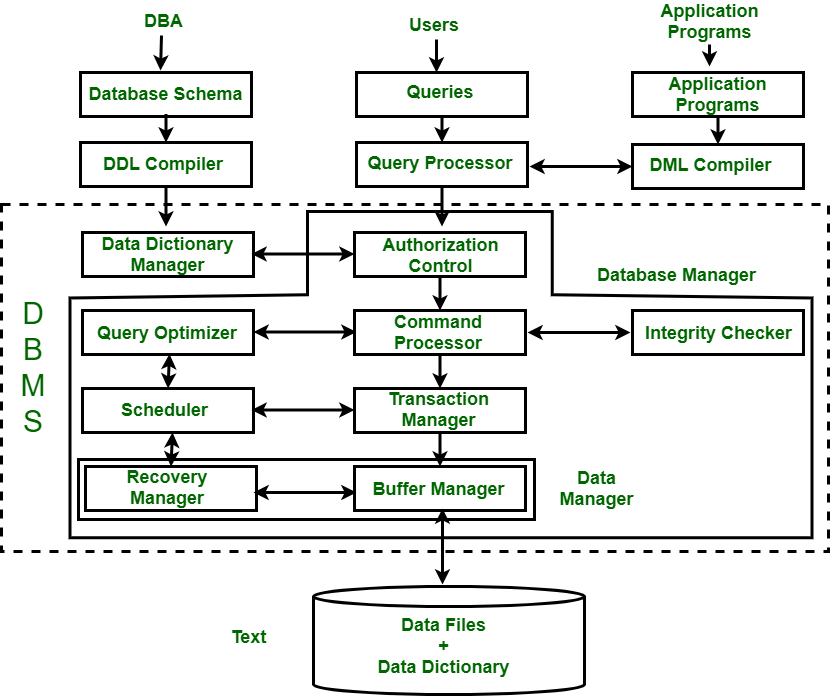Structure of Database Management System
Last Updated :
21 Apr, 2023
Database Management System (DBMS) is software that allows access to data stored in a database and provides an easy and effective method of –
- Defining the information.
- Storing the information.
- Manipulating the information.
- Protecting the information from system crashes or data theft.
- Differentiating access permissions for different users.
Data Theft: When somebody steals the information stored on databases, and servers, this process is known as Data Theft.
Note: Structure of Database Management System is also referred to as Overall System Structure or Database Architecture but it is different from the tier architecture of Database.
The database system is divided into three components: Query Processor, Storage Manager, and Disk Storage. These are explained as following below.

Architecture of DBMS
1. Query Processor: It interprets the requests (queries) received from end user via an application program into instructions. It also executes the user request which is received from the DML compiler.
Query Processor contains the following components –
- DML Compiler: It processes the DML statements into low level instruction (machine language), so that they can be executed.
- DDL Interpreter: It processes the DDL statements into a set of table containing meta data (data about data).
- Embedded DML Pre-compiler: It processes DML statements embedded in an application program into procedural calls.
- Query Optimizer: It executes the instruction generated by DML Compiler.
2. Storage Manager: Storage Manager is a program that provides an interface between the data stored in the database and the queries received. It is also known as Database Control System. It maintains the consistency and integrity of the database by applying the constraints and executing the DCL statements. It is responsible for updating, storing, deleting, and retrieving data in the database.
It contains the following components –
- Authorization Manager: It ensures role-based access control, i.e,. checks whether the particular person is privileged to perform the requested operation or not.
- Integrity Manager: It checks the integrity constraints when the database is modified.
- Transaction Manager: It controls concurrent access by performing the operations in a scheduled way that it receives the transaction. Thus, it ensures that the database remains in the consistent state before and after the execution of a transaction.
- File Manager: It manages the file space and the data structure used to represent information in the database.
- Buffer Manager: It is responsible for cache memory and the transfer of data between the secondary storage and main memory.
3. Disk Storage: It contains the following components –
- Data Files: It stores the data.
- Data Dictionary: It contains the information about the structure of any database object. It is the repository of information that governs the metadata.
- Indices: It provides faster retrieval of data item.
The structure of a Database Management System (DBMS) can be divided into three main components: the Internal Level, the Conceptual Level, and the External Level.
- Internal Level: This level represents the physical storage of data in the database. It is responsible for storing and retrieving data from the storage devices, such as hard drives or solid-state drives. It deals with low-level implementation details such as data compression, indexing, and storage allocation.
- Conceptual Level: This level represents the logical view of the database. It deals with the overall organization of data in the database and the relationships between them. It defines the data schema, which includes tables, attributes, and their relationships. The conceptual level is independent of any specific DBMS and can be implemented using different DBMSs.
- External Level: This level represents the user’s view of the database. It deals with how users access the data in the database. It allows users to view data in a way that makes sense to them, without worrying about the underlying implementation details. The external level provides a set of views or interfaces to the database, which are tailored to meet the needs of specific user groups.
The three levels are connected through a schema mapping process that translates data from one level to another. The schema mapping process ensures that changes made at one level are reflected in the other levels.
In addition to these three levels, a DBMS also includes a Database Administrator (DBA) component, which is responsible for managing the database system. The DBA is responsible for tasks such as database design, security management, backup and recovery, and performance tuning.
Overall, the structure of a DBMS is designed to provide a high level of abstraction to users, while still allowing low-level implementation details to be managed effectively. This allows users to focus on the logical organization of data in the database, without worrying about the physical storage or implementation details.
Like Article
Suggest improvement
Share your thoughts in the comments
Please Login to comment...